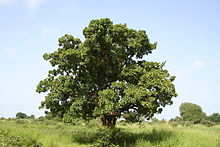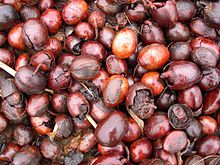Vitellaria
| Vitellaria | |
|---|---|

| |
| Shea tree | |

| |
| Shea nuts | |
| Scientific classification | |
| Kingdom: | Plantae |
| Clade: | Tracheophytes |
| Clade: | Angiosperms |
| Clade: | Eudicots |
| Clade: | Asterids |
| Order: | Ericales |
| Family: | Sapotaceae |
| Subfamily: | Sapotoideae |
| Genus: | Vitellaria C.F.Gaertn. |
| Species: | V. paradoxa |
| Binomial name | |
| Vitellaria paradoxa C.F.Gaertn. | |
| Synonyms | |
|
Butyrospermum paradoxum | |
Vitellaria paradoxa (formerly Butyrospermum parkii), commonly known as shea tree, shi tree (/ˈʃiː(ə)/, also /ʃeɪ/[2][3]), or vitellaria, is a tree of the family Sapotaceae. It is the only species in the genus Vitellaria,[4] and is indigenous to Africa.
The shea fruit consists of a thin, tart, nutritious pulp that surrounds a relatively large, oil-rich seed from which shea butter is extracted. It is a deciduous tree usually 7–15 m (23–49 ft) tall, but has reached 25 m (82 ft) and a trunk diameter of 2 m (6.6 ft).
The shea tree is a traditional African food plant. It has been claimed to have potential to improve nutrition, boost food supply in the "annual hungry season",[5] foster rural development, and support sustainable land care.[6]
Description
The tree starts bearing its first fruit when it is 10 to 15 years old; full production is attained when the tree is about 20 to 30 years old. It then produces nuts for up to 200 years.
The fruits resemble large plums 4 to 8 centimetres long weighing between 10 and 57 grams each.[7] These fruits take 4 to 6 months to ripen; the average yield is 15 to 20 kg (33 to 44 lb) of fresh fruit per tree, with optimum yields up to 45 kilograms (99 pounds). Each kilogram of fruit gives approximately 400 grams (14 ounces) of dry seeds. The fruit is edible.
Nomenclature and taxonomy
Vitellaria is a monotypic genus, i.e., it comprises only one species. The species has variously been known botanically as Vitellaria paradoxa, Butyrospermum parkii, and Butyrospermum paradoxum. Many botanical works from the late 19th and much of the 20th centuries used the name Butyrospermum parkii, which is still commonly found in the cosmetics trade. However, Vitellaria paradoxa is the oldest name (published in 1807) and has been generally used in recent decades, as necessitated by the rules of botanical nomenclature; efforts in 1962 to make Butyrospermum the official scientific name for the genus (i.e., to "conserve" the name) were unsuccessful. [8]
The species comprises two subspecies: [8][9][10]
Vitellaria paradoxa subsp. paradoxa (roughly from the Nigeria-Cameroon border westward).
Vitellaria paradoxa subsp. nilotica (Kotschy) A.N. Henry & Chithra & N.C. Nair (roughly from the Nigeria-Cameroon border eastward).
Distribution and habitat

The shea tree grows naturally in the wild in the dry savannah belt of West and South from Senegal in the west to Sudan and South Sudan in the east, and onto the foothills of the Ethiopian highlands. It occurs in 19 countries across the African continent, namely Benin, Burkina Faso, Cameroon, Central African Republic, Chad, Ethiopia, Ghana, Guinea Bissau, Ivory Coast, Mali, Niger, Nigeria, Senegal, Sierra Leone, South Sudan, Sudan, Togo, Uganda, Democratic Republic of the Congo, and Guinea. The habitat area extends over more than 5,000 kilometres (3,100 mi).[11]
A testa found at the site of the medieval village of Saouga is evidence of shea butter production by the 14th century.[12]
Uses
Shea butter has many uses and may or may not be refined. In the West it is most commonly used as an emollient in cosmetics and is less commonly used in food. Throughout Africa it is used extensively for food, is a major source of dietary fat, and for medicinal purposes. In Ghana and Nigeria, shea butter is a major ingredient for making the African black soap.

The edible protein-rich caterpillars of the moth Cirina butyrospermi which feed solely on its leaves are widely collected[13] and eaten raw, dried or fried.
Composition of shea butter

Shea butter extract is a complex fat that in addition to many nonsaponifiable components (substances that cannot be fully converted into soap by treatment with alkali) contains the following fatty acids: oleic acid (40–60%), stearic acid (20–50%), linoleic acid (3–11%), palmitic acid (2–9%), linolenic acid (<1%) and arachidic acid (<1%).[14] It also contains the vitamins A, E and F.[citation needed]
Etymology
The common name is shíyiri (in N'Ko: ߛ߭ߌ߭ߦߌߙߌ) or shísu (ߛ߭ߌ߭ߛߎ, lit. "shea tree") in the Bambara language of Mali. This is the origin of the English word, whose primary pronunciation is /ʃiː/ (rhyming with "tea"), although the pronunciation /ʃeɪ/ (rhyming with "day") is common and is listed second in major dictionaries. The tree is called ghariti in the Wolof language of Senegal, which is the origin of the French name of the tree and the butter, karité.
In Hausa language the tree is called Kaɗe or Kaɗanya. Indeed, the shea tree is so indispensable in Mole-Dagbang culinary and ethno-botanical practices that the Northern Ghanaian city of Tamale etymologically derives its name from the more traditional Dagomba name 'Tama-yile' (meaning 'Home of Shea nuts').
The tree was formerly classified in the genus Butyrospermum, meaning "butter seed". The species name parkii honors Scottish explorer Mungo Park, who learned of the tree while exploring Senegal. Park's Scottish origin is reflected in the English word shea, with a final -ea.[further explanation needed]
References
- ^ Makerere University Institute of Environment and Natural Resources. 1998. Vitellaria paradoxa. In: IUCN 2012. IUCN Red List of Threatened Species. Version 2012.2. Downloaded on 14 June 2013.
- ^ Anonymous. "shea, n. meanings, etymology and more | Oxford English Dictionary". Oxford English Dictionary.
- ^ Anonymous. "SHEA TREE | Pronunciation in English". Cambridge Free English Dictionary and Thesaurus. Retrieved 17 December 2024.
- ^ Vitellaria paradoxa. AgroForestry Tree Database. World Agroforestry Centre.
- ^ E.T. Masters; J.A. Yidana; P.N. Lovett. "Trade and sustainable forest management". FAO.org. Retrieved 2010-09-14.
- ^ National Research Council (2006-10-27). "Shea". Lost Crops of Africa: Volume II: Vegetables. Vol. 2. National Academies Press. ISBN 978-0-309-10333-6. Retrieved 2008-07-15.
- ^ Honfo, Fernande; H. N., Akissoe; Linnemann, Anita; Soumanou Mohamed; Boekel, Martinus (2014). "Nutritional Composition of Shea Products and Chemical Properties of Shea Butter: A Review". Critical Reviews in Food Science and Nutrition. 54 (5): 673–686. doi:10.1080/10408398.2011.604142. PMID 24261539. S2CID 6345738.
- ^ a b Lovett, P. N. 2015 Shea butter: properties and processing for food use. In Talbot, G. (ed.) Specialty Oils and Fats in Foods and Nutrition. Elsevier. pp. 125–158.
- ^ Buyinza, J.; Okullo, J. "Threats to conservation of Vitellaria paradoxa subsp. nilotica (Shea Butter) Tree in Nakasongola district, Central Uganda". AGRIS: International Information System for the Agricultural Science and Technology. Retrieved 2022-08-22.
- ^ Gwali, Samson; Nakabonge, Grace; Okullo, John Bosco Lamoris; Eilu, Gerald; Nyeko, Philip; Vuzi, Peter (2012-09-14). "Morphological variation among shea tree (Vitellaria paradoxa subsp. nilotica) 'ethnovarieties' in Uganda". Genetic Resources and Crop Evolution. 59 (8). Springer Science and Business Media LLC: 1883–1898. doi:10.1007/s10722-012-9905-8. ISSN 0925-9864. S2CID 207147736.
- ^ Masters, E. T.; Yidana, J. A.; Lovett, P. N. (April 2004). "Rendre la gestion plus rationnelle grâce au commerce: les produits du karité en Afrique". Unasylva. 55 (219). Food and Agriculture Organization: 46–52.
- ^ Neumann, Katharina; Kahlheber, Stefanie; Uebel, Dirk (1998). "Remains of woody plants from Saouga, a medieval west African village". Vegetation History and Archaeobotany. 7 (2): 57–77. Bibcode:1998VegHA...7...57N. doi:10.1007/BF01373925. S2CID 128820299.
- ^ Nikiema, A. & Umali, B.E. "Vitellaria paradoxa C.F. Gaertn.". - In: Van der Vossen, H.A.M. & Mkamilo, G.S. (eds.) "Plant resources of tropical Africa 14 : vegetable oils". - Wageningen : PROTA Foundation; Leiden : Backhuys; Wageningen : CTA, 2007. - 236 p. - p.182-187.
- ^ Davrieux, F., Allal, F., Piombo, G., Kelly, B., Okulo, J. B., Thiam, M., Diallo, O. B. & Bouvet, J.-M. (2010) (2010). "Near Infrared Spectroscopy for High-Throughput Characterization of Shea Tree (Vitellaria paradoxa) Nut Fat Profiles. Journal of Agricultural and Food Chemistry, 58, 7811-7819". Journal of Agricultural and Food Chemistry. 58 (13): 7811–7819. doi:10.1021/jf100409v. PMID 20518501.
{{cite journal}}: CS1 maint: multiple names: authors list (link) CS1 maint: numeric names: authors list (link)
External links
- Vitellaria paradoxa. In: Brunken, U., et al. 2008. West African Plants — A Photo Guide. Forschungsinstitut Senckenberg, Frankfurt/Main.

